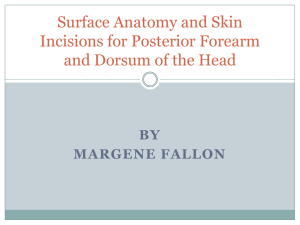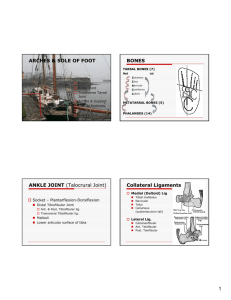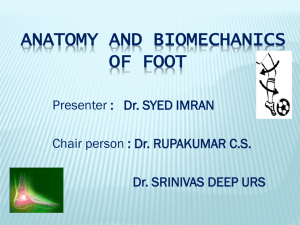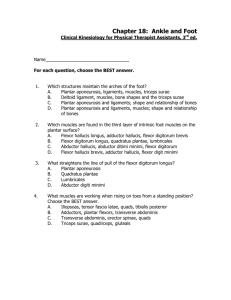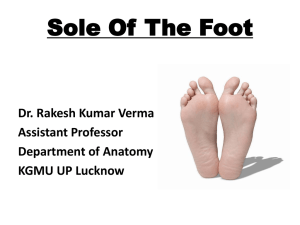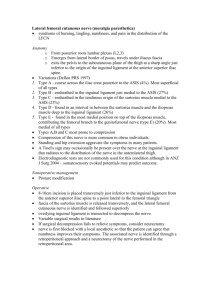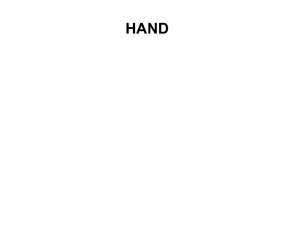Ankle and foot - WordPress.com
advertisement
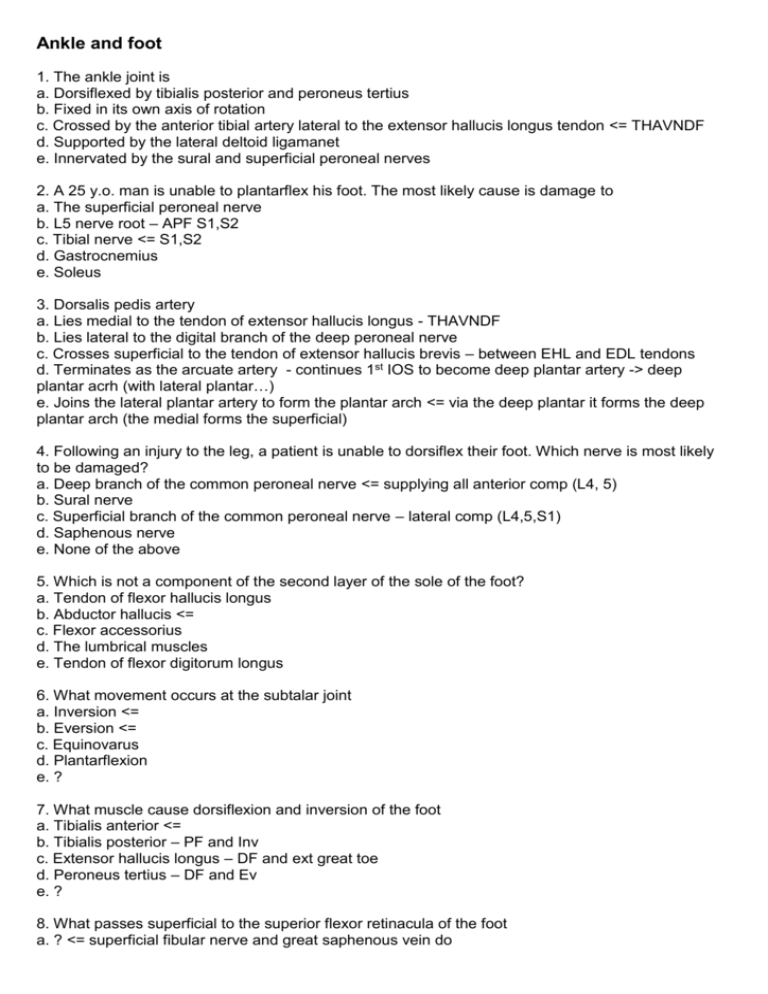
Ankle and foot 1. The ankle joint is a. Dorsiflexed by tibialis posterior and peroneus tertius b. Fixed in its own axis of rotation c. Crossed by the anterior tibial artery lateral to the extensor hallucis longus tendon <= THAVNDF d. Supported by the lateral deltoid ligamanet e. Innervated by the sural and superficial peroneal nerves 2. A 25 y.o. man is unable to plantarflex his foot. The most likely cause is damage to a. The superficial peroneal nerve b. L5 nerve root – APF S1,S2 c. Tibial nerve <= S1,S2 d. Gastrocnemius e. Soleus 3. Dorsalis pedis artery a. Lies medial to the tendon of extensor hallucis longus - THAVNDF b. Lies lateral to the digital branch of the deep peroneal nerve c. Crosses superficial to the tendon of extensor hallucis brevis – between EHL and EDL tendons d. Terminates as the arcuate artery - continues 1st IOS to become deep plantar artery -> deep plantar acrh (with lateral plantar…) e. Joins the lateral plantar artery to form the plantar arch <= via the deep plantar it forms the deep plantar arch (the medial forms the superficial) 4. Following an injury to the leg, a patient is unable to dorsiflex their foot. Which nerve is most likely to be damaged? a. Deep branch of the common peroneal nerve <= supplying all anterior comp (L4, 5) b. Sural nerve c. Superficial branch of the common peroneal nerve – lateral comp (L4,5,S1) d. Saphenous nerve e. None of the above 5. Which is not a component of the second layer of the sole of the foot? a. Tendon of flexor hallucis longus b. Abductor hallucis <= c. Flexor accessorius d. The lumbrical muscles e. Tendon of flexor digitorum longus 6. What movement occurs at the subtalar joint a. Inversion <= b. Eversion <= c. Equinovarus d. Plantarflexion e. ? 7. What muscle cause dorsiflexion and inversion of the foot a. Tibialis anterior <= b. Tibialis posterior – PF and Inv c. Extensor hallucis longus – DF and ext great toe d. Peroneus tertius – DF and Ev e. ? 8. What passes superficial to the superior flexor retinacula of the foot a. ? <= superficial fibular nerve and great saphenous vein do b. ? c. ? d. ? e. ? 9. Regarding the ossification centres of the bones of the foot, which is incorrect a. There are 3 at birth b. 5th metatarsus has 3 ossification centres c. Metatarsals have 2 centres d. ? e. ? 10. Regarding the structures passing beneath the flexor retinaculum of the ankle which is correct? a. Posterior tibial artery lies anterior to the flexor digitorum longus - TDVANH b. Flexor hallucis longus lies anterior to posterior tibial artery c. The posterior tibial artery lies anterior to the tibial nerve <= d. Flexor hallucis longus is the most anterior structure e. Flexor digitorum longus is the most posterior structure 11. Regarding the medial longitudinal arch a. Its stability is due to its bony structures - ? b. Flexor hallucis brevis acts as a bowstring c. The plantar aponeurosis is of minimal importance d. Peroneus longus supports the posterior portion e. None of the above 12. At the ankle a. The deltoid ligament attaches to the tibia and the calcaneous – 4 parts: ant and post tibiotalar, tibio nav and tibio calc b. The talus is more narrow anteriorly - post c. The capsule attaches to the neck of the talus <= d. In plantar flexion there is also eversion e. Dorsiflexion is produced by tibialis anterior and peroneus brevis 13. All of the following are ankle joint ligaments except a. Posterior tibio-fibular ligament b. Deltoid ligament - true c. Inferior transverse ligament – back of the mortise d. Posterior talofibular ligament e. Oblique ligament <= 14. Concerning the innervation of the foot a. The medial plantar nerve supplies the first 3 lumbricals- lat b. The skin of the first cleft is supplied by the superficial peroneal nerve - deep c. The plantar digital nerves supply the nail bed <= d. All interossei are supplied by the medial plantar nerve - deep e. The medial and lateral plantar nerves are branches of the common peroneal nerves - deep 15. The talus a. Has its sole articulation with calcaneous in the talocalcaneonavicular joint – no, the anatomical STJ also b. Has a long plantar ligament attached to its plantar surface – calcaenous to cuboid c. Has an upper articular surface narrow in front and broad behind - opposite d. Receives a good blood supply from dorsalis pedis, posterior tibial and peroneal arteries <= e. Is connected to navicular by the spring ligament - spring = calcaneonavicular 16. The ankle joint a. Is stabilised laterally by the deltoid ligament - med b. Relies on the fibula for weight bearing - no c. Acts purely as a hinge joint – ‘wobble’ in APF d. Has 3 ligaments radiating from the lateral malleolus <= e. Owes stability primarily to the shape of the tibiotalar articulating surface – need inf trans lig and lat mal also = mortise 17. The lumbrical muscles of the foot a. Pass forward on the lateral sides of the metatarsophalangeal joints - med b. Arise from the tendons of flexor digitorum longus <= c. Are all supplied by the lateral plantar nerve – 3:1 d. Have no real function in walking or running e. Do not insert into the extensor expansions – FHL to EE 18. With regard to the calcaneus a. It is the largest of the tarsal bones <= b. It has a convex medial surface c. The peroneal trochlea is found on it medial surface d. It articulates with the talus, navicular and cuboid <= talus via anatomical STJ, talus and navicular via TCNJ, and the cubiod via the calcaneocuboid that together with the TN part of the TNCJ = the transverse tarsal joint e. The upper surface carries articular surfaces on its posterior half 19. Regarding the ankle joint a. The lateral ligament has 2 layers b. The posterior talofibular ligament is strong and runs horizontally <= c. The deep portion of the medial ligament is triangular in shape d. The superficial portion of the medial ligament is rectangular in shape e. The nerve supply of the capsule is by the superficial peroneal nerve 20. Under the extensor retinaculum of the foot the most lateral structure is a. Sural nerve b. Dorsalis pedis artery c. Peroneus tertius <= d. Extensor digitorum longus e. Extensor hallucis longus 21. With regard to the cutaneous innervation of the lower limb a. Superficial peroneal nerve supplies the first inter-digital cleft b. Sural nerve supplies the medial malleolus c. Deep peroneal nerve supplies the third inter-digital cleft d. The medial plantar nerve supplies a greater area than the lateral <= e. Branches of the tibial nerve supply much of the dorsum of the foot 22. Regarding the ankle joint a. The capsule is attached anteriorly to the neck of the talus <= b. It has a fixed rotation of axis c. The weight bearing surfaces are the upper facet of the talus, the inferior facet of the tibia and the medial and lateral malleoli d. The lateral ligament is made up of three separate bands that all insert into the talus e. In full plantarflexion a significant amount of inversion and eversion is possible at the ankle joint 23. All of the following structures pass deep into the superior extensor retinaculum at the ankle except a. Extensor digitorum longus b. Deep peroneal nerve c. Anterior tibial artery d. Superficial peroneal nerve <= e. Peroneus tertius 24. The dermatome supplying the great toe is usually supplied by a. L3 b. L4 c. L5 <= d. S1 e. S2



